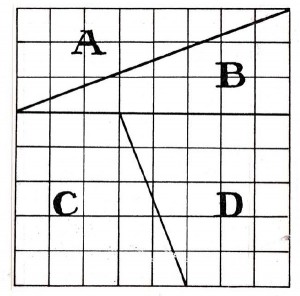 Once in awhile, mathematicians come up against something that really seems impossible on the surface. These seemingly “impossibilities” not only cause them to sit up and take notice, but often to create new rules about the way math works, or at the very least, understand math a little better.
Once in awhile, mathematicians come up against something that really seems impossible on the surface. These seemingly “impossibilities” not only cause them to sit up and take notice, but often to create new rules about the way math works, or at the very least, understand math a little better.
Be warned however, that some paradoxes are really false paradoxes, because they do not present actual contradictions, and are merely “slick logic” tricks. Other paradoxes are real, and these are the ones that shake the entire world of mathematics. There are several paradoxes that remain unsolved today. You can find a list of paradoxes here.
There are a lot of variations on the checkerboard paradox. Here’s one of my favorite paradox puzzles – can you explain it?
You’ll find need to download the PDF and cut out your four pieces.
Download Student Worksheet & Exercises
Need a HINT? I’ll give you a hint… look at the following picture:
If you cut the rectangle along the diagonal (the line that magically appears from one corner to the other) and then slide the lower triangle as shown, you can count the number of vertical lines and find that there are only nine! What happened to the tenth? You can make it magically appear if you slide the lower triangle back to its original position. So… my question to you is: Which is the line that has returned and where does it come from?
The secret is this: there is a progressive decrease in the length of the segments above the diagonal and a corresponding increase in the length of segments below. What happens is that eight of the ten lines are broken into two segments, then these sixteen segments are redistributed to form nine lines, each a trifle longer than before. Because the increase in the length of each line is slight, it is not immediately noticeable. In fact, the total of all these small increases exactly equals the length of one of the original lines. Therefore, there is actually not a line which vanishes.
Now… how would you explain the checkerboard paradox? Put your answer in the comment box below…
Exercises
Your exercise for this lesson is to not only challenge someone else with this problem, but be able to explain it to them in a way that they understand the solution.